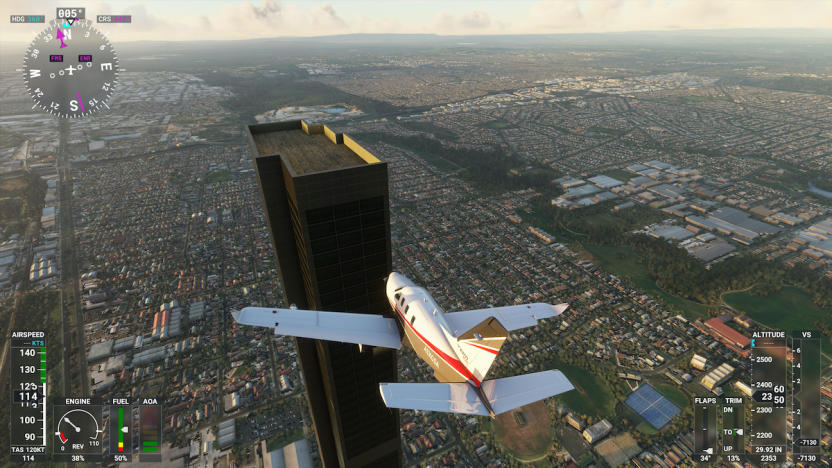OpenStreetMap
Latest

A typo created a 212-story monolith in ‘Microsoft Flight Simulator’
Microsoft Flight Simulator users recently found an unusual landmark: a 212-story monolith towering over an otherwise nondescript suburb in Melbourne, Australia.

OpenStreetMap Haiku project generates poetry about your location
Satellite Studio, a team of designers and developers, has created a fun way to make use of all the information people add to the OpenStreetMap database. It has launched OpenStreetMap Haiku, a website that generates a random haiku based on location -- all you need to do is drag the map around or click "Locate Me" to make a poem automatically appear on screen.

Facebook opens up its AI tool to OpenStreetMap users
Plugging a new address into your smartphone's map app can show you where to go in seconds. But in places like rural Bangladesh and Indonesia, there are millions of miles of roads that are still uncharted territory. Facebook now hopes its AI technology will make it easier for volunteers on OpenStreetMap to add unmapped areas. The social media giant announced today that it is opening its Map with AI tool to the entire OSM community, allowing anyone to use the tool to identify areas in Afghanistan, Bangladesh, Indonesia, Mexico, Nigeria, Tanzania and Uganda. Eventually, the company hopes to expand its mapping tool to cover the entire world.

OpenStreetMap can give directions to your destination
Some third-party apps are already using OpenStreetMap data to give you directions, but now you can look up routes directly on its website. It works just like Google Maps or any of its other alternatives: type in a location and then your destination to find out how to get there by car, bike or foot. Obviously, that's nothing groundbreaking, but the crowdsourced map's developers are hoping it would bring new blood to the website. The more direct users it has, the more people there are to add or correct the names of locations and infrastructure, or even add simple stuff that make a map better, such as one-way streets, dead-ends or U-turns. OpenStreetMap's completely free, so you can visit it anytime you want to get into the spirit of crowdsourced cartography.

Collaborative mapping project will chart the Amazon's rivers
Crowdsourced mapping efforts are helpful in many places, but they're most useful in corners of the globe where even the professional maps are incomplete -- you can address gaps in coverage that might be difficult for distant observers to fill. And OpenStreetMap knows it. The community-driven site has just launched Mapazonia, a project that asks you to help chart the Amazon's rivers and roads. It's not expecting comprehensive data when the area spans 2.1 million square miles, but it believes that your first-hand knowledge could put missing towns on the map and fix inaccuracies in the shoreline.

Foursquare gives Superusers web links to map editing tools
Foursquare switched to editable OpenStreetMap data for its check-in services over a year ago, but many of its users wouldn't know it when there hasn't been a way to tweak maps through place pages. As of today, Foursquare is encouraging a little more interaction: Superusers (frequent contributors) in Australia, Brazil, Germany and the UK can now click a web link to edit a location in OpenStreetMap. Those who aren't keen on signing up for OSM can still leave a note with their proposed changes. There's no mention of plans to expand access to regular users, but the firm expects additional rollouts to Superusers in areas where map data is less than trustworthy.

Skobbler updates Android app with turn-by-turn navigation and offline maps, offers free light option
Skobbler has had some success in the mobile mapping market, thanks in part to iOS's historical first-party weakness in the area. But, with Apple offering its own solution and Google breaking Maps free from the OS-update chains, it's facing a more difficult landscape in which to make its mark. So it only makes sense to beef up its offerings on other platforms, and Google-fans are reaping the benefits. An update to Skobbler's Android app is finally adding the turn-by-turn directions and offline maps, which have been offered on the iOS edition for sometime. The full version has a starting price of just $1 (with one free map download), and the company is even offering a free light version for those who aren't sure they want to part ways with a Washington (or a Sacagawea) just yet. Interestingly, the update is actually an entirely new app called GPS Navigation & Maps +offline, though existing users of ForeverMap 2 will be able to upgrade for free. Navigation & Maps also makes the move to OpenStreetMap to provide data, which has both its problems and its perks. Going open source means that Skobbler can undercut competitors like TomTom and Navigon, but there are lingering questions about the accuracy of the database. You'll find both the full version and the 14-day trial light edition at the source links if you're looking for an alternative to Google Maps.%Gallery-188647%

Telenav Scout for Phones to go 3D, get crowd-sourced traffic reporting in 2013
There are plenty of choices to meet your mobile mapping needs, from feature-rich offerings from big names like Google, Apple and Nokia to crowd-sourced services like Waze. Telenav's Scout app falls somewhere in between, and today the company announced that it'll get both 3D buildings and landmarks and crowd-sourced traffic reporting (backed by TomTom's database) later this year. Graphically, Scout in 3D looks similar to Google Maps and will initially be available for major metro areas in the US. As for traffic reporting, Telenav will be asking its 34 million subscribers to report accidents and traffic jams, and will update its database in real-time. That means that as road conditions change, Scout'll suggest faster alternate route options to get you from point A to point B hassle-free. No word exactly when these new capabilities will make it to users, but when they do arrive later this year, both premium and free users will get 'em. In the meantime, check out the video of the new 3D maps in action after the break.

Craigslist quietly switching to OpenStreetMap data
TPM is reporting that Craigslist is embedding maps on its housing adverts from crowdsourced mapping site, OpenStreetMap. While the listings-site isn't boasting of the change, it's the fourth major name to dump Google's service after Foursquare, Wikipedia Mobile and Apple. While Mountain View has cut the cost of accessing its Maps API, it looks like budget-conscious corporations may be looking elsewhere.

Flickr brings in Nokia map data for precise geotagged photos, Instagram shots just got eerily accurate
Open Street Map has been helping Flickr display geotagged shots for some time. That crowdsourced map data has led to more than a few photos being located in a gray blob, however, which is why Yahoo just struck a deal to put Nokia maps into as many nooks and crevices of the world as possible. The addition will make sure that Instagram photo tour of Africa is often accurate down to the street corner, not to mention give a slightly Finland-tinged look to the maps themselves. Open Street Map isn't going away, but it's now being used only for those areas where regular coverage is spotty or non-existent. The images already apply to any existing and upcoming uploads -- there will be no question that self-portrait was taken in Tanzania.

Inside the process of creating navigational maps
PC Pro UK has a fascinating article about the navigational maps we use on our devices and how they are made. This behind-the-scenes look examines how the four biggest digital map providers maintain their vast repository of information. Nokia-owned Navteq has a database that includes 24 million miles of roads and makes 2.4 million changes to its database each day, says Navteq's vice president Frank Pauli. These changes are made based on information provided by users, governments and its own mapping efforts. Another big map provider is Dutch company TomTom. TomTom is not as big as Navteq, but it is able to effectively use data supplied by its devices which phone home with information. It also has an active base of users who send in 15 million map changes each year. There's also Google which PC Pro describes as having a "mishmash" of maps, some of which are licensed and some of which are generated in-house. Lastly is the OpenStreetMap project which started off small and has emerged as a major player in the recent years. OpenStreetMap relies almost entirely on user-based submissions that can modify a map within minutes. You can read more about each of these solutions in the PC Pro UK article. [via Slashdot]

Blindsquare uses Foursquare data to guide the visually impaired
Blindsquare is giving guidance systems for the visually disabled a new twist with user-generated Foursquare data, text-to-speech, GPS and some OpenStreetMap mojo. While users are out and about, the app narrates their trip via headphones with information about nearby places, intersections or guidance to their destination. One shake of the iPhone or iPad gives users their current location and a second shake checks them in on Foursquare. The app can also be controlled via a Bluetooth remote while the device sits in a pocket or backpack. After going from concept to completion in six months, it's now out of beta and available on the App Store for $14.99. Sonar gauntlets won't let you check-in to your haunts? Hit the source link to step up that location-based social networking.

OpenStreetMap gets acknowledged in iPhoto credits
After iPhoto landed on iOS in March, people quickly discovered the app used OpenStreetMap data for the map tiles. At the time, there was no attribution given to OSM but that has changed in the latest version of iPhoto, which was released earlier this week. OpenStreetMap pointed out in a tweet that Apple now lists OpenStreetMap contributors in the long list of acknowledgements for the app. Richard Fairhurst, OpenStreetMap Foundation board member, explains how the foundation nudged Apple to get the attribution added to iPhoto, The OSM Foundation has made informal contact with staff at Apple and, in addition, one of our volunteer mappers who is an iOS developer spoke to people at Apple. We believe it was the latter that precipitated adding the attribution - it's great to have such an active and engaged community! OpenStreetMap is a crowdsourced mapping platform that provides free map data in exchange for an attribution. Both FourSquare and Wikipedia use OSM data in their apps. [Via TalkingPointsMemo Idea Lab]

Mobile Miscellany: week of April 2nd, 2012
Not all mobile news is destined for the front page, but if you're like us and really want to know what's going on, then you've come to the right place. This past week, CyanogenMod gained a new logo, Google acquired a mobile payments company and we learned that the HTC EVO 4G LTE for Sprint will include an embedded SIM card. These stories and more await after the break. So buy the ticket and take the ride as we explore the "best of the rest" for this week of April 2nd, 2012.

Apple using OpenStreetMap data in iPhoto for iPad
If you purchased the new iPhoto for iOS yesterday, you may be surprised by the map tiles in the app. As noticed by 512 pixels, they are not from Google Maps. After some initial confusion over the source of the map data, the OpenStreetMap Foundation confirmed that Apple is using map data from the OpenStreetMap project. Apple is using the OpenStreetMap data to render its own tiles in iPhoto. The map data Apple uses in iPhoto is supposedly old (circa 2010) and is used without attribution, a situation OpenStreetMap is working with Apple to remedy. This move is a welcome step away from Google Maps, which Apple uses in other apps like its iPhoto desktop app and its Maps application for iOS. It's also nice to see Apple moving towards its own mapping solution, especially after acquiring map companies like PlaceBase and 3D mapping company C3 Technologies.

Foursquare.com checks in with OpenStreetMap, checks out of Google Maps API
Foursquare's been quite the active startup lately, adding NFC support for Android 4.0 and releasing its app for the PlayStation Vita. The company isn't quite done being the mayor of Busyville, though, announcing a switch from Google Maps API to OpenStreetMap data-based MapBox Streets for Foursquare.com. Foursquare cited greater flexibility and support for other startups as reasons for the switch, although it also admits that Google's decision to start charging for its Maps API spurred the search for an alternative. Meanwhile, a quick check of the Foursquare app still yielded Google Maps results, so it appears the change is limited to the web site for now. Also, no word on whether Foursquare's awarding MapBox Streets a BFF badge.

MapQuest for Android brings free turn-by-turn navigation, OpenStreetMap support to Google lovers
Oh, sure -- iOS had it first, but the Android flavor of MapQuest's mobile app has OpenStreetMaps. How d'ya like those apples ? The aforesaid app has just found its way into the Android Market, and as with the iPhone version, it's 100 percent free to download. Unlike most other alternatives, this one provides gratis voice guidance / turn-by-turn navigation, voice search, a map toolbar, walking / driving directions, live traffic flow information and a couple of "major" new adds. Those are OpenStreetMap (OSM) data -- useful for allowing consumers to use the app internationally -- as well as the ability to directly report errors onto the map. Check out the source link to learn more, and head on over to the Market (if you're rocking v1.6 and up) to get your download on. Happy trails, as they say.

Grey Area announces Shadow Cities, first location-based iPhone MMO
Searching for a new MMORPG for your iPhone? Look no further than the platform's first location-based massively multiplayer title, Shadow Cities, courtesy of Finnish developer Grey Area. Virtual World News checks in with some interesting information about the game, including the fact that the it tracks your location via OpenStreetMap and creates a game world based on your city before populating it with various enemies. Gameplay consists of exploring, hunting down rogue spirits, and obtaining new spells as you level. Casting spells is accomplished by drawing rune-like shapes on the iPhone's screen, and players can also join one of two factions and battle other players in the same area of the game world. The game is slated to be released in late 2010, and you can sign up for an email notification on the official Grey Area website. You can also view a brief teaser trailer after the cut.

First look: Rally Up, a social network for real friends
I have to admit it: I like location-based social networking apps. Probably my favorite to date has been FourSquare, which I love because I'm the "Mayor" of a couple dozen locations. But this type of app isn't for everyone. My wife, for example, says that she thinks they're a bit too much like stalking (to which I replied, "there's an app for that"), so she won't use them. Rally Up is a new location-based social network (that's so awkward to say) that has several features that may sway my wife. The free app for iPhone, and soon for iPad, lets you set granular friend preferences. What does that marketing speak mean? Easy -- you set your real friends to "real" on a slider, which means that they get full notifications (i.e., "Steve is at the Blue Bonnet Café) and their check-ins show up in your feed. The next slider setting is "feed," which is for those folks who you want to know about, but you don't want to receive push notifications from. Next on the slider? "Lurker." Here, you can see what's happening with a friend, but you don't let them see what you're up to. And finally, there's "mute." What do you use mute for? It's for all of those people who you started following because of social pressure, but who you really don't want to follow.

AndNav2 brings turn-by-turn navigation to the European Android jet set
Although G1 users have that sweet compass-based Street View implementation, we haven't heard much about turn-by-turn nav on Android until now -- AndNav2 is a new alpha app that uses OpenStreetMap data to get you where you're going. It's currently supported in the UK, Ireland, Germany, Austria, France, Denmark, Spain, Switzerland, and Italy -- apparently the folks at AndNav don't have server enough for a Stateside implementation, although they hope to have this remedied in the future. In the meantime, it looks like Americans hoping to get from one place to another will have to either continue to rely on their superior sense of direction or, more likely, their Knight Rider GPS.[Via Googleandblog]













